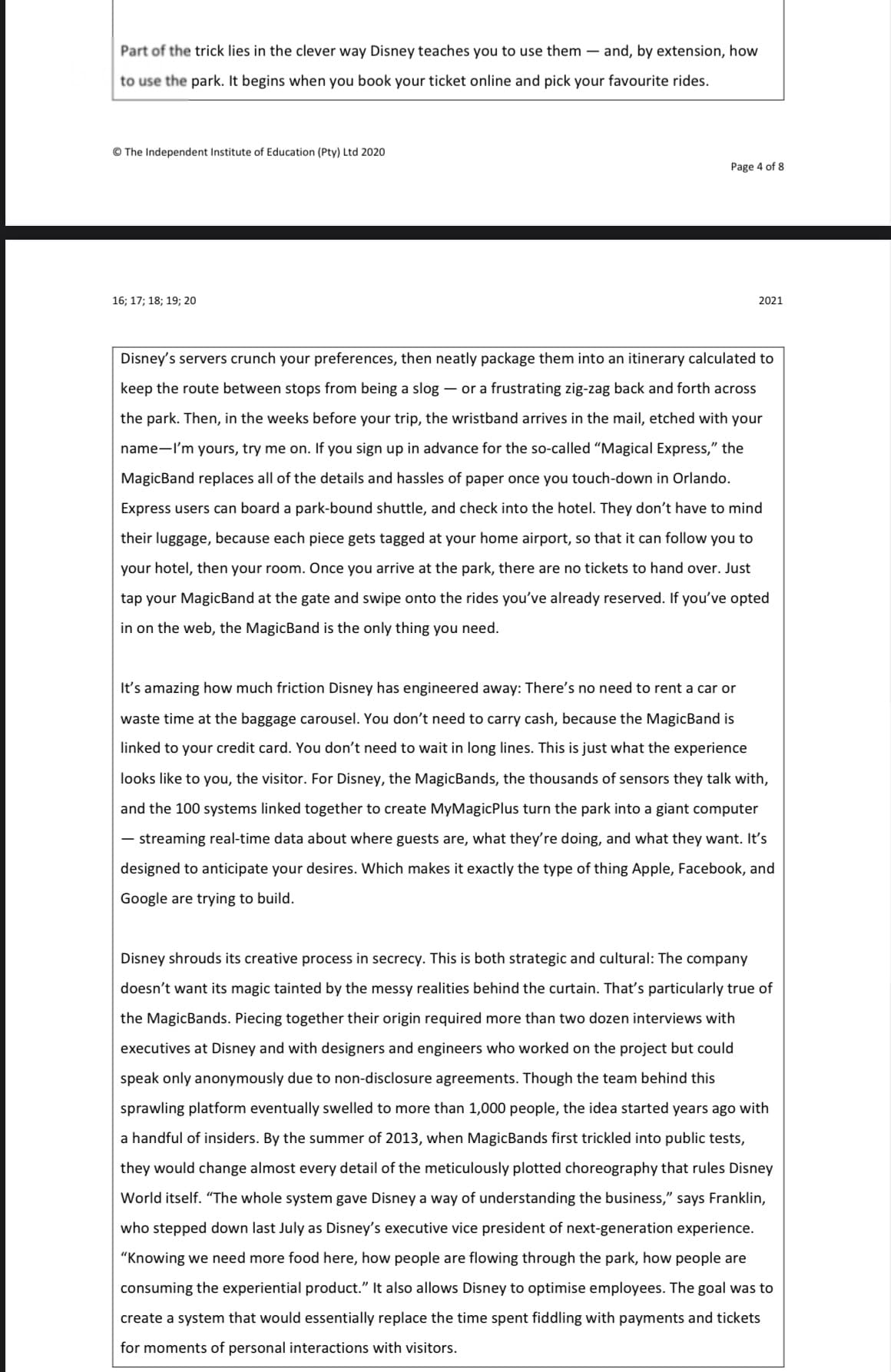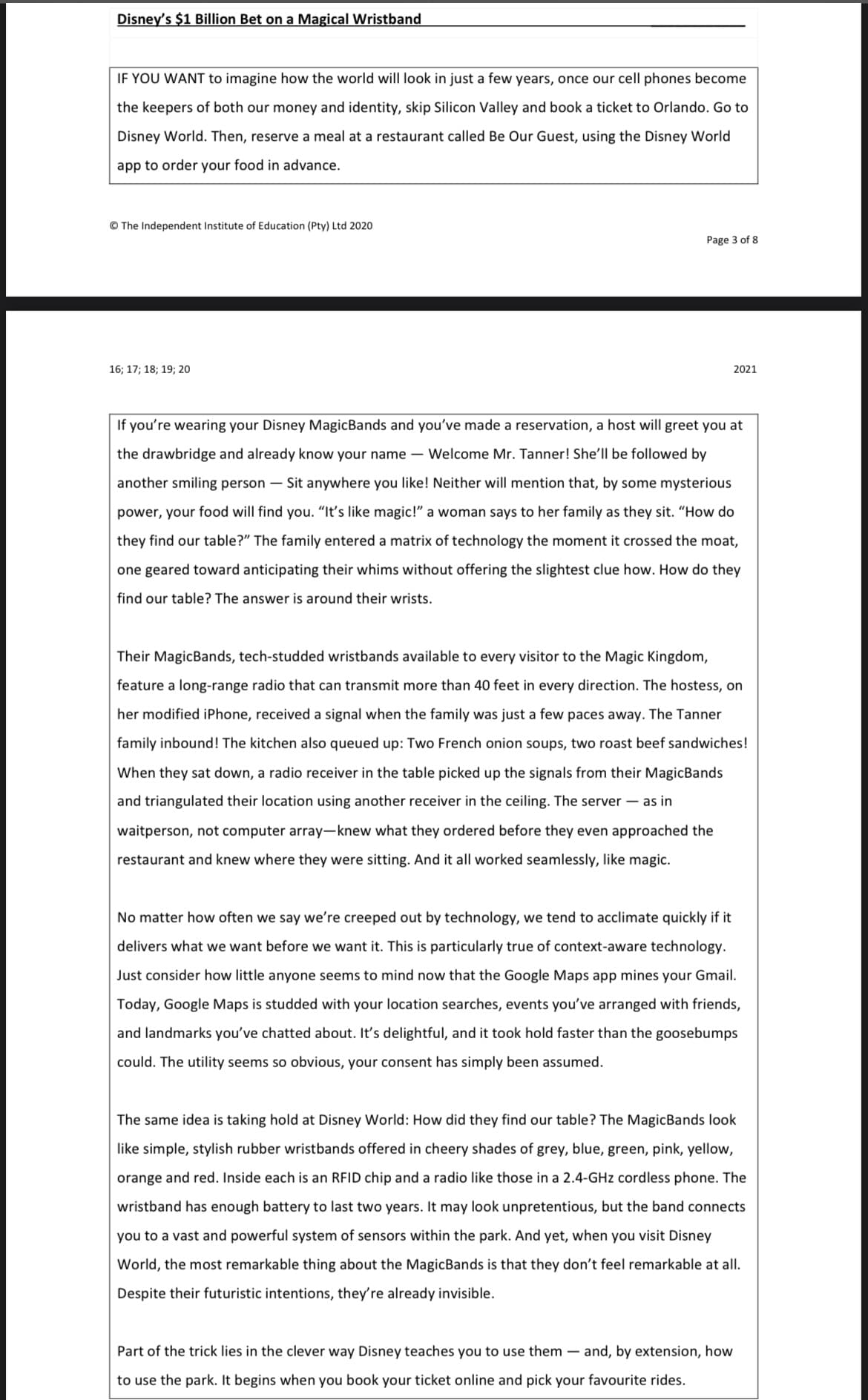How Disney World has used MagicBands as part of an enterprise system (ES) to exploit ICT.
How Disney World has used MagicBands as part of an enterprise system (ES) to exploit ICT.
Fundamentals of Information Systems
8th Edition
ISBN:9781305082168
Author:Ralph Stair, George Reynolds
Publisher:Ralph Stair, George Reynolds
Chapter2: Hardware And Software
Section: Chapter Questions
Problem 3PSE
Related questions
Question
How Disney World has used MagicBands as part of an enterprise system (ES) to exploit ICT.

Transcribed Image Text:Part of the trick lies in the clever way Disney teaches you to use them – and, by extension, how
to use the park. It begins when you book your ticket online and pick your favourite rides.
© The Independent Institute of Education (Pty) Ltd 2020
Page 4 of 8
16; 17; 18; 19; 20
2021
Disney's servers crunch your preferences, then neatly package them into an itinerary calculated to
keep the route between stops from being a slog – or a frustrating zig-zag back and forth across
the park. Then, in the weeks before your trip, the wristband arrives in the mail, etched with your
name-'m yours, try me on. If you sign up in advance for the so-called "Magical Express," the
MagicBand replaces all of the details and hassles of paper once you touch-down in Orlando.
Express users can board a park-bound shuttle, and check into the hotel. They don't have to mind
their luggage, because each piece gets tagged at your home airport, so that it can follow you to
your hotel, then your room. Once you arrive at the park, there are no tickets to hand over. Just
tap your MagicBand at the gate and swipe onto the rides you've already reserved. If you've opted
in on the web, the MagicBand is the only thing you need.
It's amazing how much friction Disney has engineered away: There's no need to rent a car or
waste time at the baggage carousel. You don't need to carry cash, because the MagicBand is
linked to your credit card. You don't need to wait in long lines. This is just what the experience
looks like to you, the visitor. For Disney, the MagicBands, the thousands of sensors they talk with,
and the 100 systems linked together to create MyMagicPlus turn the park into a giant computer
- streaming real-time data about where guests are, what they're doing, and what they want. It's
designed to anticipate your desires. Which makes it exactly the type of thing Apple, Facebook, and
Google are trying to build.
Disney shrouds its creative process in secrecy. This is both strategic and cultural: The company
doesn't want its magic tainted by the messy realities behind the curtain. That's particularly true of
the MagicBands. Piecing together their origin required more than two dozen interviews with
executives at Disney and with designers and engineers who worked on the project but could
speak only anonymously due to non-disclosure agreements. Though the team behind this
sprawling platform eventually swelled to more than 1,000 people, the idea started years ago with
a handful of insiders. By the summer of 2013, when MagicBands first trickled into public tests,
they would change almost every detail of the meticulously plotted choreography that rules Disney
World itself. "The whole system gave Disney a way of understanding the business," says Franklin,
who stepped down last July as Disney's executive vice president of next-generation experience.
"Knowing we need more food here, how people are flowing through the park, how people are
consuming the experiential product." It also allows Disney to optimise employees. The goal was to
create a system that would essentially replace the time spent fiddling with payments and tickets
for moments of personal interactions with visitors.

Transcribed Image Text:Disney's $1 Billion Bet on a Magical Wristband
IF YOU WANT to imagine how the world will look in just a few years, once our cell phones become
the keepers of both our money and identity, skip Silicon Valley and book a ticket to Orlando. Go to
Disney World. Then, reserve a meal at a restaurant called Be Our Guest, using the Disney World
app to order your food in advance.
© The Independent Institute of Education (Pty) Ltd 2020
Page 3 of 8
16; 17; 18; 19; 20
2021
If you're wearing your Disney MagicBands and you've made a reservation, a host will greet you at
the drawbridge and already know your name – Welcome Mr. Tanner! She'll be followed by
another smiling person – Sit anywhere you like! Neither will mention that, by some mysterious
power, your food will find you. "It's like magic!" a woman says to her family as they sit. "How do
they find our table?" The family entered a matrix of technology the moment it crossed the moat,
one geared toward anticipating their whims without offering the slightest clue how. How do they
find our table? The answer is around their wrists.
Their MagicBands, tech-studded wristbands available to every visitor to the Magic Kingdom,
feature a long-range radio that can transmit more than 40 feet in every direction. The hostess, on
her modified iPhone, received a signal when the family was just a few paces away. The Tanner
family inbound! The kitchen also queued up: Two French onion soups, two roast beef sandwiches!
When they sat down, a radio receiver in the table picked up the signals from their MagicBands
and triangulated their location using another receiver in the ceiling. The server – as in
waitperson, not computer array-knew what they ordered before they even approached the
restaurant and knew where they were sitting. And it all worked seamlessly, like magic.
No matter how often we say we're creeped out by technology, we tend to acclimate quickly if it
delivers what we want before we want it. This is particularly true of context-aware technology.
Just consider how little anyone seems to mind now that the Google Maps app mines your Gmail.
Today, Google Maps is studded with your location searches, events you've arranged with friends,
and landmarks you've chatted about. It's delightful, and it took hold faster than the goosebumps
could. The utility seems so obvious, your consent has simply been assumed.
The same idea is taking hold at Disney World: How did they find our table? The MagicBands look
like simple, stylish rubber wristbands offered in cheery shades of grey, blue, green, pink, yellow,
orange and red. Inside each is an RFID chip and a radio like those in a 2.4-GHz cordless phone. The
wristband has enough battery to last two years. It may look unpretentious, but the band connects
you to a vast and powerful system of sensors within the park. And yet, when you visit Disney
World, the most remarkable thing about the MagicBands is that they don't feel remarkable at all.
Despite their futuristic intentions, they're already invisible.
Part of the trick lies in the clever way Disney teaches you to use them – and, by extension, how
to use the park. It begins when you book your ticket online and pick your favourite rides.
Expert Solution
This question has been solved!
Explore an expertly crafted, step-by-step solution for a thorough understanding of key concepts.
Step by step
Solved in 3 steps with 1 images

Knowledge Booster
Learn more about
Need a deep-dive on the concept behind this application? Look no further. Learn more about this topic, computer-science and related others by exploring similar questions and additional content below.Recommended textbooks for you

Fundamentals of Information Systems
Computer Science
ISBN:
9781305082168
Author:
Ralph Stair, George Reynolds
Publisher:
Cengage Learning

Fundamentals of Information Systems
Computer Science
ISBN:
9781305082168
Author:
Ralph Stair, George Reynolds
Publisher:
Cengage Learning